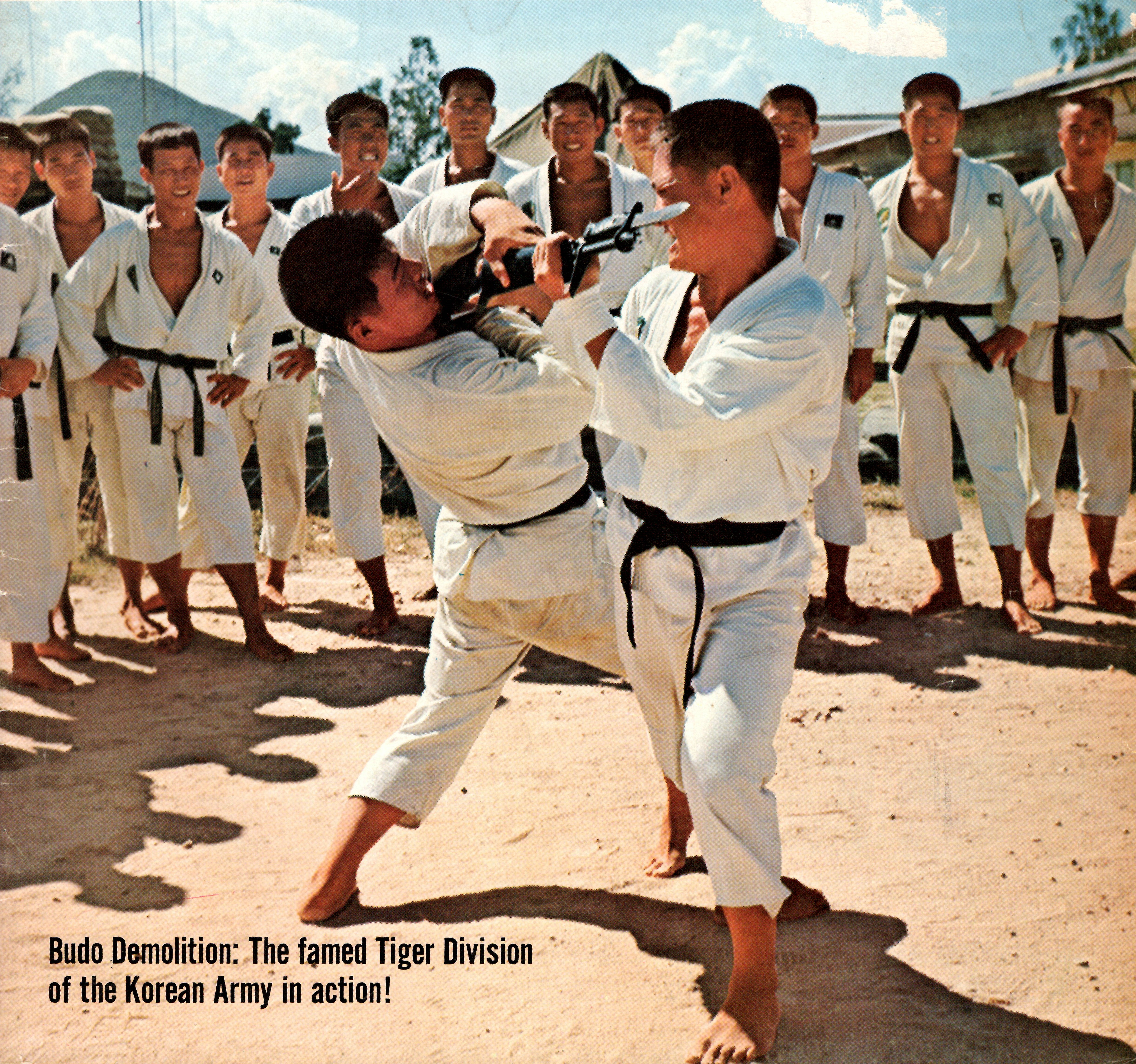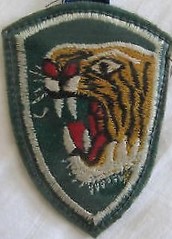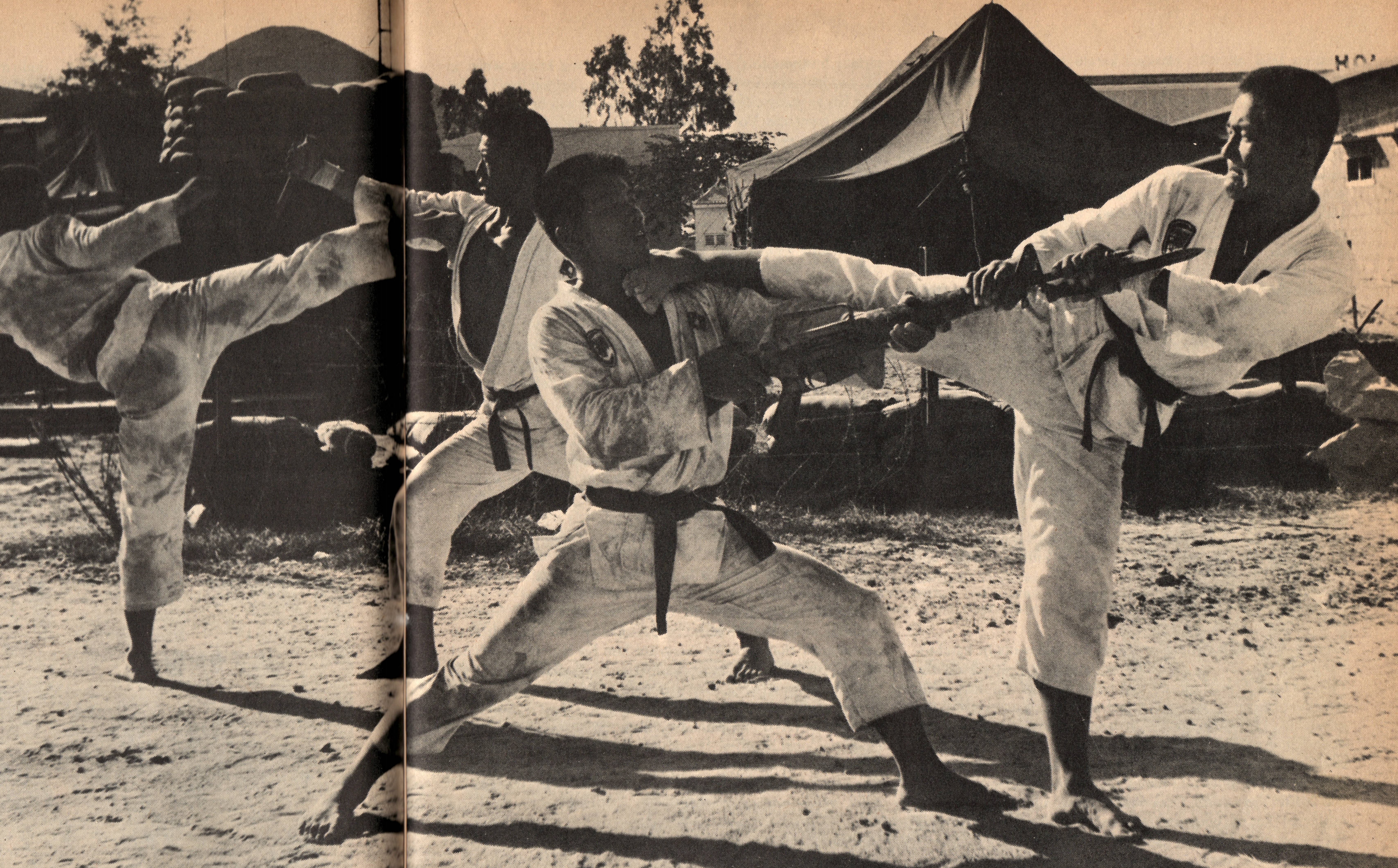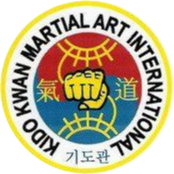BUDO DEMOLITION: THE FAMED TIGER DIVISION OF THE KOREAN ARMY IN ACTION!

Taekwondo in Action! Combat Karate of the first order! The Tiger Division of the Korean Army is chalking up victory after victory in Vietnam thanks to intensive martial arts training! By Jack Swift 1968 originally published in Black Belt issue November 1968. USED WITH PERMISSION BY THE AUTHOR prior to his passing!

SCENE: A group of solider gathered around. It is a bull-session. The subject under discussion: The Tiger Division of the Korean Army. The soldiers are engrossed. One, a lean, tanned GI pushes back his beret, squints into the darkness and looks out to see a mountain of burning embers.

So goes the legend, and just in case you’re casting a cynical eye as to the Tiger Division’s aptitude in the use of the martial arts, the record speaks for itself. If there was ever a primer on combat karate, these troops would write it. In grueling periods daily, every troop in the Tiger Division trains in the taekwondo method, the official karate organization of Korea. At one time there were many factions, but int he past year or so they have all been absorbed by the International Taekwondo Federation, with its headquarters in Seoul. In fact, with the Koreans, and even in many areas in Vietnam, taekwondo is synonymous with karate. Numerous Vietnamese do not even understand the word karate-but mention taekwondo and their faces light up with recognition.
At Qui Nhon, division headquarter, visitors are surprised to see sparking white karate uniforms – and a sea of black belts – virtually in the middle of a combat zone. While on actual operations away from their base the Tigers work out in field gear, but at the training center everyone wears a gi, and keeps it in immaculate inspection shape as any other military uniform. On the left-hand side of the gi, each troop wears the proud division emblem of a roaring tiger. On the other side,m if he is an instructor, the soldier wears the black insignia of a fist, with white dots above indicating how many degrees of black belt ranks he holds. Commander of the massive taekwondo training corps of the Tiger Division is Captain Yoon Dong Ho, himself a third degree black belt. But the rugged, intelligent captain is no armchair commander. He is on hand daily at the dirt arena, watching the troops go through their paces and often teaching a special class of officers himself. Beginning the day’s schedule, Captain Yoon glances at the wall and grins as he indicates a beautiful calendar girl pictured above the dates. “My sister,” he says simply. Captain Yoon is responsible for the official taekwondo training of more then 15,000 Tiger troops in Vietnam! Although popular belief holds otherwise, there are actually just somewhat more than 200 black holds in the Tiger ranks, at last count. Of these, three are fourth dans, 29 are third dans, 57 are second dans and 115 are first dans. There are roughly 600 red belts (equivalent to brown) and 2,300 blue belts, as well as some 9,000 troops holding advanced degrees of white belt. In additions, approximately 2,900 men recently began their training in Vietnam. Many of these, of course, already hold rank they won in Korea.
Each element of Tiger infantry arriving in Vietnam goes through intensive schooling at Qui Nhon as a class. The 26th of these classes began in July (1968), to run for just over a month. The sessions lead off with classical karate techniques under the direct supervision of Sergeant Jun Jae Gun, head taekwondo instructor for the Meng Ho in Vietnam. Sergeant Jun, one of the division’s tough trio of fourth dans, displays a certificate signed by Choi Hong Hi, Taekwondo Federation President. When a trooper is promoted in Vietnam, however, he is awarded a military certificate of training by his supplement company commander, who acts as representative of Lieutenant Colonel Jai Chun Ko, Division Field Commander, in the presentation. All promotions are recognized by the Taekwondo Federation. In cases of promotion to the higher grades, however, special recognition is often meted out. Sergeant Kim Duk Ki, associate of Sergeant Jun, was recently awarded his third day by Lieutenant General Chae Myung Shin, Field Headquarters Commander of all of ROK Forces in Vietnam. “The major objective of our formal taekwondo classes,” asserts Captain Yoon, “is to take the minds of our troops, and replace civilian thinking with military spirit and fierceness. “Tiger’ is the nickname the division has been tagged with because of the fierce nature we have demonstrated in combat. We intend to live up to it.” Captain Yoon reinforced that statement with an impromptu demonstration of his own favorite techniques. Choosing a brawny trooper with a bayonet, the captain rushed him, parrying the weapon with a sweeping outside block and following with an onslaught of power punches with the elbow, palm heel and fist. He ended with a forearm strike to the windpipe, which he explained is effective when one wants to silence the enemy quickly. Key elements in hand-to-hand combat, the commander explained, are attacking the weapon directly or the hand that holds it while simultaneously attacking the most vulnerable spot in reach, then pressing the assault to keep the enemy off balance while finishing him off.
Stressing physical fitness in preparation for the application of these techniques, Captain Yoon said his troops rely heavily upon powerful, smashing blows against the smaller Viet Cong and North Vietnamese Communist. As an addition point, he explained that the enemies are often undernourished because of their long treks from the North, and therefore may fall easily under a strong attack. “One particular situation where we encounter hand-to-hand fighting,” Captain Yoon continued, “is when the VC hide in bunkers and Tiger patrols do not have heavy weapons available to blow them apart. In such a case the troops simply go in after them. The VC stand little chance against my men in close-quarter fighting.” In addition to the training of their own infantry, Tiger taekwondo instructors teach U.S. and Army of the Republic of Vietnam (ARVN) soldiers, as well as some other allied forces infantry soldiers. At other installations throughout South Vietnam the Koreans teach their art to allied forced and Vietnamese civilians of both sexes and all ages. There are scores of Korean black belts who are not members of the Tiger Division, but who teach taekwondo to the local troopers and civilians. Many of these men belong to the larger White Horse Division, ROKFV. Especially in populated places such as the Tan Son Nhut Air Base – Saigon area, taekwondo has become as popular as baseball is to Americans among the youth. Today, self defense is serious business to the Vietnamese, as no one knows when a VC terrorist squad will break into his home. Saigon itself probably has as many different styles of karate as will be found anywhere, from the Vo Vietnam (Vietnam Traditional Boxing) form to the secretive schools of the Chinese Cholon section. But taekwondo is there to stay.
The Tiger Lair
Several miles away from the main training area on the Qui Nhon Airbase where the new arrivals to the division and the Vietnamese hold classes, the Tiger instructors have their own compound, carved out of the verdant Vietnam countryside. Bordered on two sides by mountains and flanked by the South China Sea, the encampment nestles into a serene and clean smelling natural cradle, somehow out of place amidst the turmoil of war. The side has never been successfully attacked, and no one remembers the last time even a single mortar landed with the perimeter. The perimeter itself is defined by roll upon roll of barbed wire, machine gun posts and sandbag reinforced bunkers. When not actually leading class the instructors perform most of their military duties wearing their gis, often barebacked in the all pervading heat. Somehow it doesn’t seem quite right to see a fierce fighting man carting pails of water for a makeshift shower or spreading rolls of barbed concertina wire – until you recall how budo masters of ancient times made their charges perform menial tasks before they would be accepted into the esoteric order of the martial arts. Perhaps this accounts in part for their dedication and the respectful attitude the troops invariably display.
Capitan Yoon decides to review the instructors’ training methods, so he has the select corps organize into a squadron to demonstrate their prowess. Sergeant Lee Jin Ho, whose official title is post instructor, leads the formation. In the highest military order, they fall swiftly into ranks. The commander steps forward and receives the squadron’s salute. The he turns the command over to Sergeant Ho. At a signal the Tigers break ranks and rush into new formations with precision reminiscent of the Roman Legions. The first squad is directed to show taekwondo forms. They snap through the katas in coordinated pairs, demonstration the adroitness that can only come from the rigid military discipline. The forms are technically the same as classical Korean Karate, but are execute with the confident power of soldiers who have seen what their stuff can do to a man. The next group forms behind a line of boards, bricks an tiles. Stacks of four and five bricks, up to 15 titles and four one inch boards lie before them. The unit is called to attention, salutes again, and assumes a ready posture. Sergeant Lee barks a single command and a dozen heads, hands and fists smash into the solid objects. Not a singe one remains unbroken. “Unlike karate training outside a combat zone,” Captain Yoon explains, “it is important here that the troops be able to turn their techniques into devastating, bone crushing blows. There is no place for mild strikes in combat, when a VC is trying to push a bayonet into your stomach,” he points out. Therefore, the compound is peppered with makiwara punching boards, and the Tigers spend much time conditioning their body weapons. Also, anywhere in Vietnam there are plenty of sand bags, which are are used to protect all kinds of constructions. They make excellent striking bags for karateman.
The next unit int he schedule is to display free fighting. The commander again explains that this form of fighting is used to test the Tiger’s skill against one another, rather to demonstrate the actual methods of close-order combat, as a fight on the battlefield is nearly always over in an instant. The sparring matches are exhibitions of superb technique and control. Perhaps the only recognizable difference between these matches held in sport tournaments is the consistent power the soldiers put behind their blows, and their concentration on “hard” techniques rather than elusive ones. At last a final group will show what happens when an unarmed Tiger meets a VC with a combat knife, or a bayonet fixed to his AK-47 rifle. Two pairs of soldiers stride to the center of the stony, hard dirt arena, face the commander and render a snappy salute. Then they fall into a four man square and await orders. Sergeant Lee barks a command and the best of the best explode into action. One gladiator leaps for a knife which has been thrown into the arena. He jams it, hard, at another, who violently kicks the striking hand and jumps shoulder height, scissoring the attackers neck and tumbling him forward onto the unyielding ground with a crash. The knife spins away.
Meanwhile, another black belt catches a rifle with fixed bayonet thrown to him from the sidelines. With a guttural shout he lunges for his opponent. The defender spins to the left, brings his knee sharply inward against the weapon and at the same time rolls the attacker onto his own shoulder and tears at his windpipe. It is over in seconds! The couples repeat the performance again and again, smashing full tilt against each other. Every time, the attacker thrusts hard with his weapon. It is just less than miraculous that the practice arena does not turn into a blood bath! At another command they instantly stand erect. Every gi is covered with reddish brown dirt. The uniform of one shows a long rip right between the shoulder blades where he judged the sweep of a knife to the fraction of an inch. The entire corps regroups, Captain Yoon gestures his approval, and the elite fighting men break ranks without a word – to clean up the mess.
Korean Budomen
The Qui Nhon military base is a highly impressive training center where the best of the Korean budomen instill qualities of desired military spirit in their trainees while teaching them how to save their lives.
Initiated as the “Capital Infantry Division,” the Tiger Division was activated June 20, 1949 in Seoul Korea, with the mission of security for the capital city of Seoul. It was charged with additional security of the 38th parallel in Ongjin in September 1950, the division began to prove itself in heavy fighting during battles at Ahn-kang and Kyung-joo along the defense line of the Nak-dong River in the southeastern part of the country. Following the successful In-chon landing by MacArthur’s forces, the division penetrated deep into the North across the 38th parallel, overrunning a number of enemy strongholds and advancing near to the Korea-Manchuria border. As their ability became recognized the division was committed repeatedly, and saw the armistice signed while fighting at the front in the spring of 1953. During the conflict they fought on Capitol Hill, Lighting Hill, Venus Hill, the Unknown Hill and throughout the central part of the country. They captured over 9,920 enemy, killed more then 91,000, and captured more than 31,000 weapons. As a result of their valor the division was awarded five ROK Presidential Citations and a U.S. Presidential Citation, an ROK National Assembly award and 42 other plaudits. After the armistice, the division had already been dubbed with the “Tiger” laurel, and was deployed along the front line of the central part of the Korea DMZ. They remained under continued training and constant combat readiness.
Upon approval of the National Assembly, the division was directed to combat in the Republic of Vietnam August 20, 1965. Three separate elements arriveQui Nhon November 1, after four weeks preliminary training. That month it received its Area of Responsibility, which consisted of 1,400 square kilometers in Binh Dihn Province, in central Vietnam. The division’s general mission objectives are to protect travel routes, military installations and facilities within its TAOR, and to assist the Republic of Vietnam in its pacification plan by eliminating Viet Cong in the area and helping the people rebuild their destroyed homes.
Since 1965, the Tiger Division has stabilized security within their area to an impressive degree. The TAOR itself has expanded from 1,400 to 3,600 square kilometers. As of mid-June the Tigers had killed more than 9,000 enemy, captured nearly 3,000 and counted over 4,500 defectors, as well as seizing nearly 4,000 weapons, all this since their arrival in Vietnam. All this leaves little room for doubt about whom historians will count as the true elite of Vietnam combat. In the ranks of the VC and NVA, mention of these ferocious Korean gladiators brings shudders to the comrades. Even as he fights those from North Vietnam and the Viet Cong, the Tigerman knows that he has full command of his body and of his mind. When he is faced with hand-to-hand combat, he need not only rely on the ferocity of his rifle to equalize the score. He can hammer out punches in machine gun rapidity or swing a full flogging kick with sufficient powerful force to gain the advantage. When a man is trained in karate, or to be more specific, taekwondo, he is ahead of the game and the Viet Cong, that crap-shooting armada of insurgent forces and the crack North Vietnamese troops who come to do battle, know full well that the Tigers with their taekwondo as well as armaments are tough men to beat.
The roots of taekwondo are in Korea and for the ROK GIs who enter the Tiger ranks, the intensive routine of training in the martial art is strictly par for the course, their bodies responding to cue. No doubt every Tigerman hopes to use his martial arts training sometime in tournament as well as he is doing in combat. That is the dream of every GI in the ROK division. That they will be especially trained is part of today. And it is a part of tomorrow – and victory – which will attest to the ferocity of the Tiger.
The Tigers, under Maj. Gen. Lew Pyong Hyon and with taekwondo’s Capt. Yoon, have been making headlines through out the world. They are the only troops, it has been said, who fight fire with fire, who are using guerrilla techniques and ambush techniques in much the same manner as the Viet Cong. In a war such as this where the boundary lines are questionable, where there is no “front line” and where your neighbor can turn into your enemy, such techniques are indispensable. Thanks to hand-to-hand techniques and the combat karate emphasis of this militia, the odds are clearly shaping up in the Tiger Division’s ledger. Thanks to taekwondo, the Tigers are smashing the enemy with no holds barred and, if anyone doubts it, plenty of contact!
![]()
